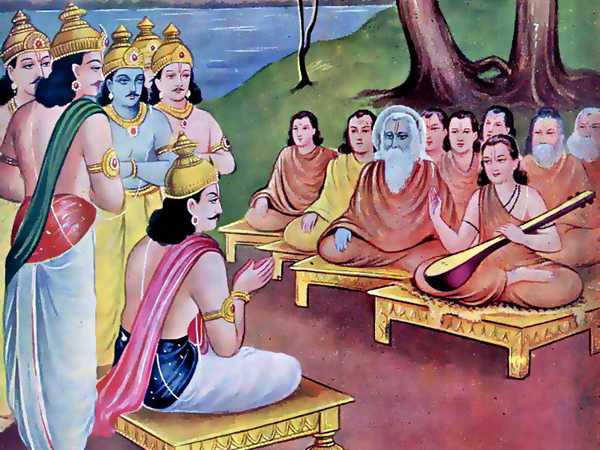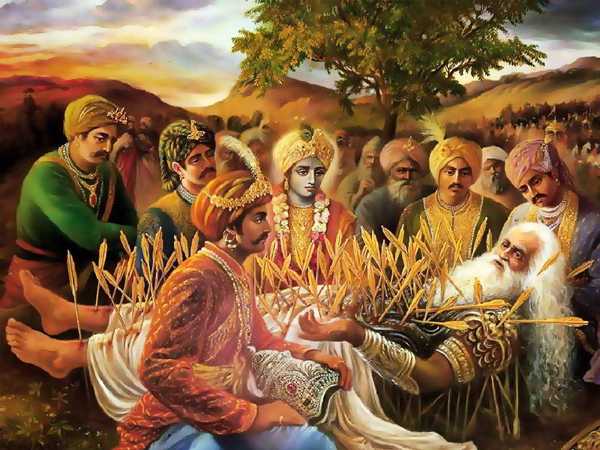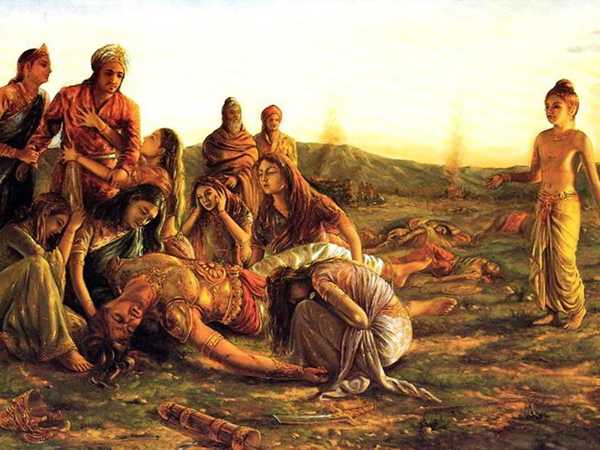Chapter 307

‘”Janaka said, Thou hast, O foremost of Rishis, said that Unity is theattribute of that which is Akshara (Indestructible) and variety ormultiplicity is the attribute of what is known as Kshara (Destructible).I have not, however, clearly understood the nature of these two. Doubtsare still lurking in my mind. Ignorant men look upon the Soul as enduedwith the incident of multiplicity. They, however that are possessed ofknowledge and wisdom regard the Soul to be one and the same. I how-ever,have a very dull understanding. I am, therefore, unable to comprehend howall this can happen. The causes also that thou hast assigned for theunity and the multiplicity of Akshara and Kshara I have almost forgottenin consequence of the restlessness of my understanding. I therefore,desire to hear thee once more discourse to me on those same incidents ofunity and multiplicity, on him who is knowing, on what is destitute ofknowledge, on Jiva-soul, Knowledge, Ignorance. Akshara, Kshara, and onthe Sankhya and the Yoga systems, in detail and separately and agreeableto the truth.
“‘Vasishtha said, I shall tell thee what thou askest! Listen however, tome, O monarch, as I expound to thee the practices of Yoga separately.Contemplation, which constitutes an obligatory practices with Yogins, istheir highest puissance[1619]. Those conversant with Yoga say thatContemplation is of two kinds. One is the concentration of the mind, andthe other is called Pranayama (regulation of breath). Pranayama is saidto be endued with substance; while concentration of mind is unendued withit.[1620] Excepting the three times when a man passes urine and stoolsand eats, one should devote the whole of his time to contemplation.With-drawing the senses from their objects by the aid of the mind, onepossessed of intelligence, having made oneself pure, should agreeably tothe two and twenty modes of transmitting the Prana breath, unite theJiva-soul with That which transcends the four and twentieth topic (calledIgnorance or Prakriti)[1621] which is regarded by the wise as dwelling inevery part of the body and as transcending decay and destruction. It isby means of those two and twenty methods that the Soul may always beknown, as heard by us. It is certain that this practice of Yoga is hiswhose mind is never affected by evil passions. It is not any otherperson’s. Dissociated from all attachments, abstemious in diet, andsubduing all the senses, one should fix one’s mind on the Soul, duringthe first and the last part of the night, after having, O king ofMithila, suspended the functions of the senses, quieted the mind by theunderstanding, and assumed a posture as motionless as that of a block ofstone. When men of knowledge, conversant with the rules of Yoga, becomeas fixed as a stake of wood, and as immovable as a mountain, then arethey said to be in Yoga. When one does not hear, and smell, and taste,and see; when one is not conscious of any touch; when one’s mind becomesperfectly free from every purpose; when one is not conscious of anything, when one cherishes no thought; when one becomes like a piece ofwood, then is one called by the wise to be in perfect Yoga. At such atime one shines like a lamp that burns in a place where there is no wind;at such a time one becomes freed even from one’s subtile form, andperfectly united with Brahma. When one attains to such progress, one hasno longer to ascend or to fall among intermediate beings. When personslike ourselves say that there has been a complete identification of theKnower, the Known, and K now-ledge, then is the Yogin said to behold theSupreme Soul.[1622] While in Yoga, the Supreme Soul displays itself inthe Yogin’s heart like a blazing fire, or like the bright Sun, or likethe lightning’s flame in the sky. That Supreme Soul which is Unborn andwhich is the essence of nectar, that is seen by high-souled Brahmanasendued with intelligence and wisdom and conversant with the Vedas, issubtiler than what is subtile and greater than what is great. That Soul,though dwelling in all creatures, is not seen by them. The creator of theworlds, He is seen only by a person endued with wealth of intelligencewhen aided by the lamp of the mind. He dwells on the other share of thickDarkness and transcends him called Iswara.[1623] Persons conversant withthe Vedas and endued with omniscience call Him the dispeller of Darkness,stainless, transcending Darkness, without attributes and endued therewith.
“‘This is what is called the Yoga of Yogins. What else is the indicationof Yoga? By such practices do Yogins succeeded in beholding the SupremeSoul that transcends destruction and decay. This much that I have toldthee in detail concerns about the science of Yoga. I shall now discourseto thee of that Sankhya philosophy by which the Supreme Soul is seenthrough the gradual destruction of errors.[1624] The Sankhyas, whosesystem is built on Prakriti, say that Prakriti, which is Unmanifest, isthe foremost. From Prakriti, they say, O monarch, the second principlecalled Mahat, is produced. It is heard by us that from Mahat flows thethird principle called Consciousness. The Sankhyas blessed with sight ofthe Soul say that from Consciousness flow the five subtile essence ofsound, form, touch, taste, and scent. All these eight they call by thename of Prakriti. The modifications of these eight are sixteen in number.They are the five gross essence of space, light, earth, water, and wind,and the ten senses of action and of knowledge including the mind. Men ofwisdom devoted to the Sankhya path and conversant with all its ordinancesand dispensations regard these four and twenty topics as embracing thewhole range of Sankhya enquiry. That which is produced becomes merged inthe producing. Created by the Supreme Soul one after another, theseprinciples are destroyed in a reverse order. At every new Creation, theGunas start into existence in the lateral order (as stated above), and(when Destruction comes) they merge, (each into its progenitor) in areverse order, like the waves of the ocean disappearing in the ocean thatgives them birth. O best of kings, this is the manner in which theCreation and the Destruction of Prakriti takes place. The Supreme Beingis all that remains when Universal Destruction takes place, and it is Hethat assumes multifarious forms when Creation starts into life. This iseven so, O king, as ascertained by men of knowledge. It is Prakriti thatcauses the Overpresiding Purusha to thus assume diversity and revert backto unity. Prakriti also herself has the same indications. Only fullyconversant with the nature of the topics of enquiry knows that Prakritialso assumes the same kind of diversity and unity, for when Destructioncomes she reverts into unity and when Creation flows she assumesdiversity of form. The Soul makes Prakriti, which contains the principlesof production or growth, to assume manifold forms. Prakriti is calledKshetra (or soil). Transcending the four and twenty topics or principlesis the Soul which is great. It presides over that Prakriti or Kshetra.Hence, O great king, the foremost of Yatis say that the Soul is thePresider. Indeed, it has been heard by us that in consequence of theSoul’s presiding over all Kshetras He is called the Presider. And becauseHe knows that Unmanifest Kshetra, He is, therefore, also calledKshetrajna (Knower of Kshetra). And because also the Soul enters intoUnmanifest Kshetra (viz., the body), therefore he is called Purusha.Kshetra is something quite different from Kshetrajna. Kshetra isUnmanifest. The Soul, which transcends the four and twenty principles, iscalled the Knower. Knowledge and the object known are different from eachother. Knowledge, again, has been said to be Unmanifest, while the objectof knowledge is the Soul which transcends the four and twenty principles.The Unmanifest is called Kshetra. Sattwa (understanding), and also Iswara(the supreme Lord), while Purusha, which is the twenty-fifth principlehas nothing superior to it and is not a principle (for it transcends allprinciples and is only called a principle conventionally). This much Oking, is an account of the Sankhya philosophy. The Sankhyas called thecause of the universe, and merging all the grosser principles into theChit behold the Supreme Soul. Rightly studying the four and twenty topicsalong with Prakriti, and ascertaining their true nature, the Sankhyassucceed in beholding That which transcends the four and twenty topics orprinciples.[1625] Jiva in reality is that very Soul which transcendsPrakriti and is beyond the four and twenty topics. When he succeeds inknowing that Supreme Soul by dissociating himself from Prakriti, he thenbecomes identifiable with the Supreme Soul. I have now told thee everything about the Sankhya System truly. Those who are conversant with thisphilosophy succeed in attaining are subject to error have directcognisance of Brahma. They that succeed in attaining to tranquillity.Indeed, as men whose understanding are subject to error have directcognisance of Brahma. They that succeed in attaining to that state havenever to come back to this world after the dissolution of their bodies;while as regards those that are said to be emancipate in this life,puissance, and that indescribable felicity which attaches itself toSamadhi, and immutability, become theirs, in consequence of their havingattained to the nature of the Indestructible.[1626] They who behold thisuniverse as many (instead of seeing it as one and uniform) are said tosee incorrectly. These men are blind to Brahma. O chastiser of foes, suchpersons have repeatedly to come back into the world and assume bodies (indiverse orders of Being). They who are conversant with all that has beensaid above become possessed of omniscience, and accordingly when theypass from this body no longer become subject to the control of any morephysical frames. All things, (or the entire universe), have been said tobe the result of the Unmanifest. The Soul, which is the twenty-fifth,transcends all things. They who know the Soul have no fear of returningto the world.'”



